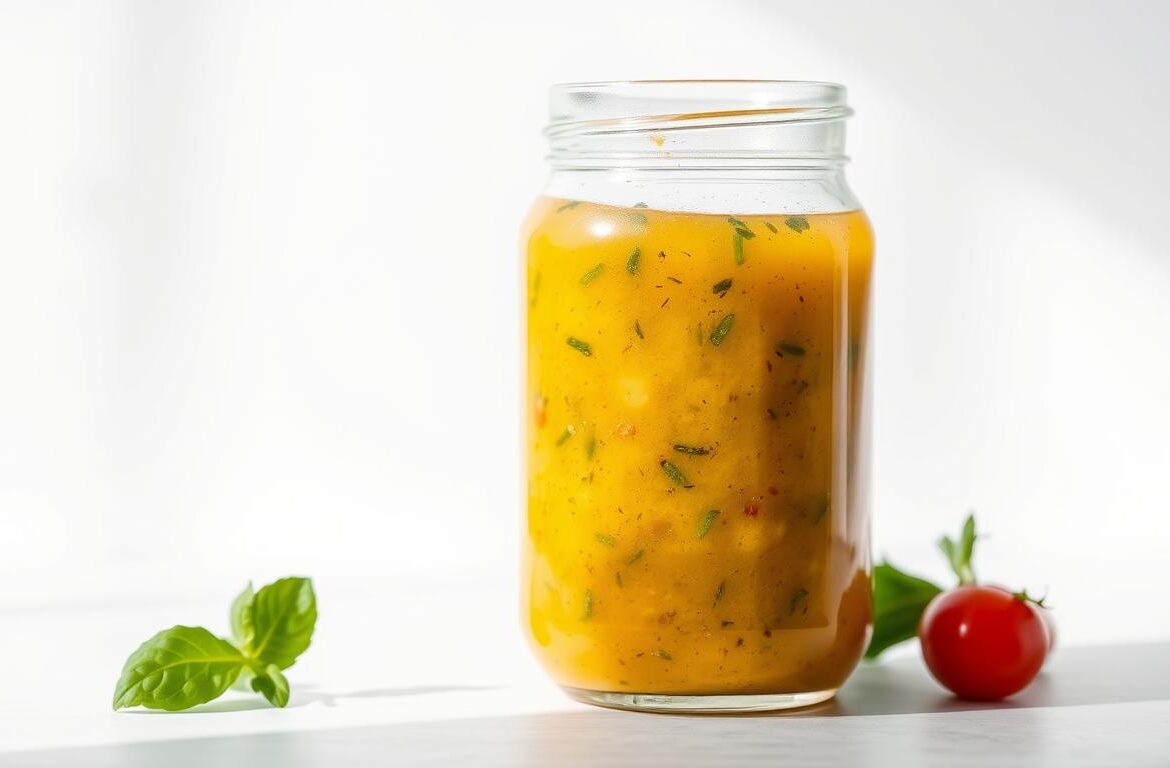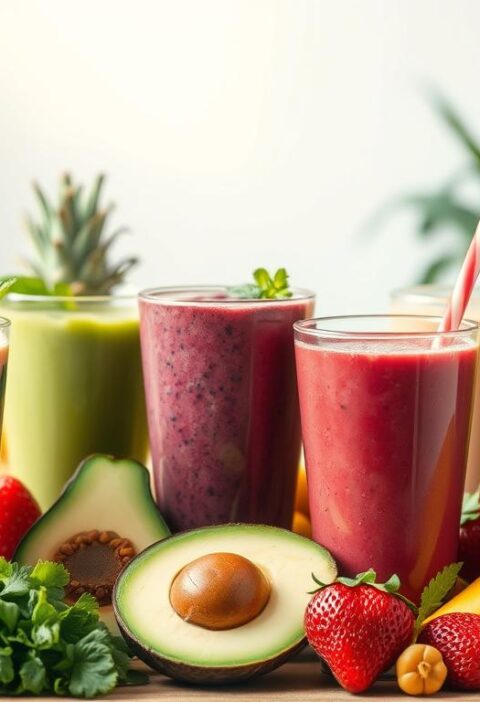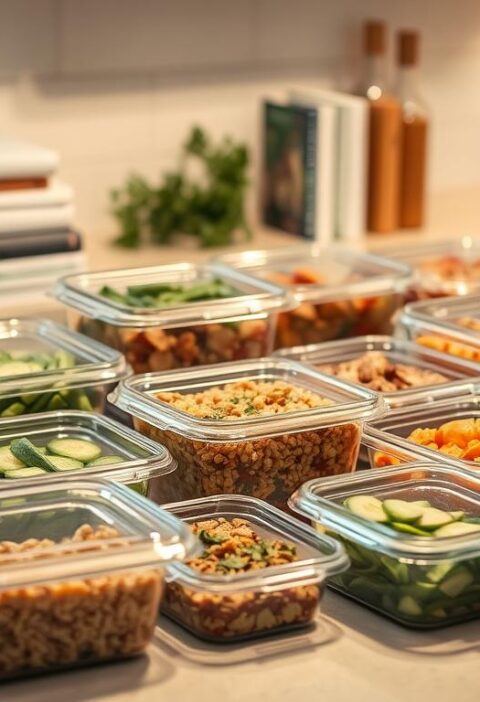Have you ever stood in front of the fridge, staring at fresh greens? You’re not alone. Many of us struggle to make a simple salad tasty. But what if you could make a delicious quick dressing in just a few minutes?
Imagine making different homemade salad dressings faster than boiling water. With simple ingredients and basic tools, you can make dressings that make your salads better.
By the end of this article, you’ll know how to make quick dressings. They’re not only tasty but also easy to make.
Key Takeaways
- Learn how to make a variety of homemade salad dressings in under 5 minutes.
- Discover simple ingredients that can elevate your salad game.
- Understand the benefits of making your own salad dressings at home.
- Get tips on customizing your dressings to suit your taste.
- Explore different flavor combinations to keep your salads interesting.
Why Make Your Own Salad Dressings
Making your own salad dressings can really improve your salads. They offer health benefits and save money too.
Health Benefits of Homemade vs. Store-Bought
Homemade salad dressings are healthier than store-bought ones. Store-bought dressings have preservatives and lots of sugar or salt. But, homemade dressings let you pick fresh, healthy ingredients.
Control Over Ingredients and Additives
With homemade salad dressings, you choose what’s in them. You can skip the additives and preservatives found in many store-bought ones. For example, using fresh garlic and lemon juice adds flavor without extra ingredients.
Customizing for Dietary Needs
Homemade salad dressings can be made to fit your diet. Whether you’re gluten-free, vegan, or watching calories, you can adjust the ingredients. This way, everyone can enjoy a salad that fits their needs.
Cost Savings and Reduced Waste
Making your own salad dressings saves money and reduces waste. Store-bought dressings can be pricey, and their packaging adds to waste. Homemade dressings let you buy ingredients in bulk and avoid waste. Plus, you can make small batches to avoid expired or spoiled dressing.
Essential Ingredients for 5-Minute Dressings
To make salad dressings in 5 minutes, you need the right ingredients. You probably have most of them at home. With a few key items, you can make many tasty dressings for your salads.
Oils and Vinegars to Keep on Hand
Most dressings start with oil and acid, like vinegar or citrus juice. Having different oils and vinegars lets you try new flavors.
Best Oils for Different Flavor Profiles
Choosing the right oil changes your dressing’s taste. Olive oil gives a rich, fruity flavor. Avocado oil has a mild, buttery taste good for creamy dressings. For a lighter taste, use grape seed oil or canola oil.
Vinegar Varieties and Their Uses
Vinegars add a tangy, acidic taste. Balsamic vinegar is sweet-and-sour, great for vinaigrettes. Apple cider vinegar and white wine vinegar work for many dressings. For less acidity, try rice vinegar or champagne vinegar.
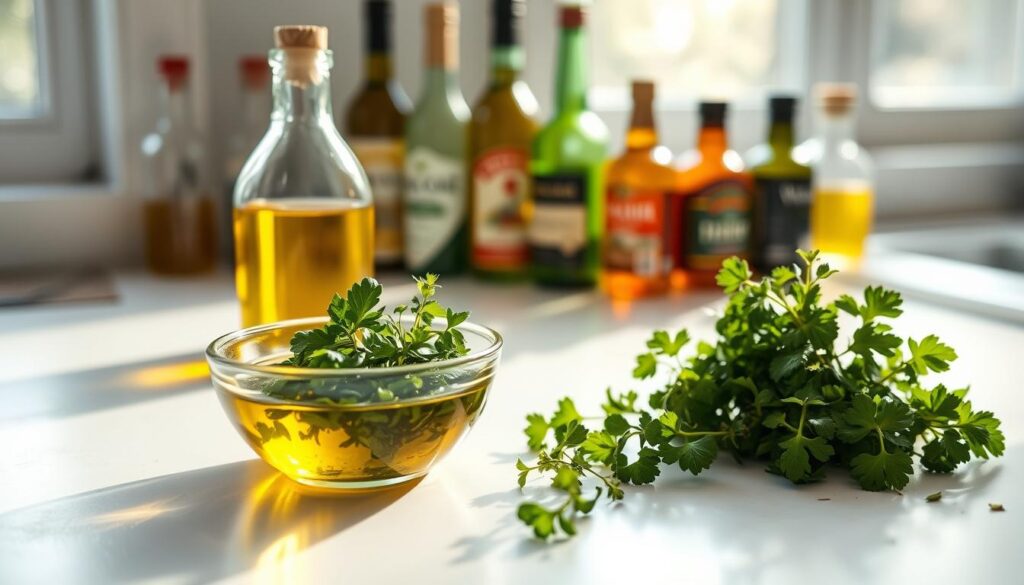
Flavor Enhancers and Emulsifiers
Ingredients like garlic, mustard, and honey add depth. For a smooth dressing, use egg yolks or mayonnaise.
Fresh Herbs and Seasonings
Fresh herbs and seasonings make dressings better. Add chopped fresh herbs like parsley or basil for a bright taste. Salt and pepper balance flavors. Other seasonings like paprika or garlic powder add interesting notes.
| Ingredient | Use | Example |
|---|---|---|
| Olive Oil | Vinaigrettes, Mediterranean-inspired dressings | Balsamic Vinaigrette |
| Balsamic Vinegar | Sweet-and-sour dressings, vinaigrettes | Classic Balsamic Vinaigrette |
| Garlic | Flavor enhancer | Creamy Garlic Dressing |
| Fresh Herbs | Adds freshness and flavor | Basil and Lemon Dressing |
The Basic Formula for Perfect Homemade Salad Dressing
Making the perfect homemade salad dressing is easy. It’s all about balancing flavors and getting the right consistency. This basic formula lets you try different ingredients and make your own homemade salad dressing recipes.
The Classic 3:1 Oil-to-Acid Ratio
The key to most salad dressings is the oil-to-acid ratio. A classic mix is 3 parts oil to 1 part acid. For example, mix 3 tablespoons of olive oil with 1 tablespoon of apple cider vinegar to begin. Adjust this ratio to your liking; some like it tangier, others milder.
Quick Emulsification Techniques
Emulsification mixes liquids that don’t usually go together, like oil and vinegar. To make a smooth vinaigrette recipe, you need to emulsify well.
Shaking in a Jar Method
Shaking ingredients in a jar is a simple way to emulsify. Put your oil, acid, and flavorings in a jar. Then, shake hard for about 30 seconds. This method is quick and easy.
Blender and Whisk Methods
For a smoother dressing, blend the ingredients. Whisking is a manual way that works well for small batches or adding texture.
Adjusting Flavors to Taste
After mixing your basic dressing, adjust the flavors. Taste and add salt, herbs, spices, or other seasonings as needed. You can also tweak the oil-to-acid ratio. The secret to a great homemade salad dressing is to keep trying until you get it just right.
As
“The discovery of a new dish does more for human happiness than the discovery of a new star.” – Jean Anthelme Brillat-Savarin
shows, making your own salad dressings is a joy.
5 Quick Homemade Salad Dressing Recipes
Make your salad game better with these 5 easy homemade salad dressings. They’re perfect for any meal. Making your own dressings is healthier and lets you pick your flavors. Here are five quick recipes to start with.
Classic Balsamic Vinaigrette
A timeless favorite, classic balsamic vinaigrette is a staple in many kitchens. It’s simple to make and pairs well with a variety of salads.
Ingredients and Preparation
To make classic balsamic vinaigrette, you need 2 parts olive oil, 1 part balsamic vinegar, 1 teaspoon Dijon mustard, salt, and pepper. Whisk these ingredients together until they are well combined. You can adjust the ratio of oil to vinegar to suit your taste.
Salad Pairings
This vinaigrette is perfect for caprese salads, green salads, or as a marinade for vegetables. Try it with mixed greens, cherry tomatoes, and mozzarella for a classic Italian-inspired salad.
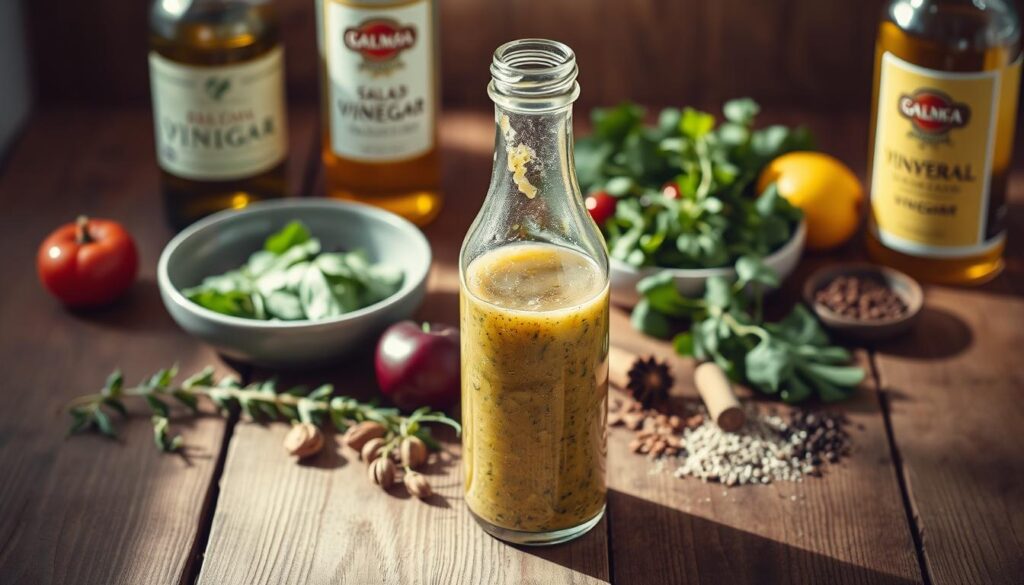
Creamy Greek Yogurt Dressing
For a healthier alternative to traditional creamy dressings, try using Greek yogurt. This dressing is not only delicious but also packed with protein.
Ingredients and Preparation
Mix 1/2 cup Greek yogurt with 2 tablespoons lemon juice, 1 tablespoon chopped fresh dill, 1 minced garlic clove, salt, and pepper. Whisk until smooth and adjust seasoning as needed.
Salad Pairings
This creamy dressing is great with spinach salads, cucumber salads, or as a dip for vegetables. It’s also a fantastic accompaniment to grilled chicken or fish salads.
Zesty Lemon Dijon Dressing
Add a burst of citrus flavor to your salads with this zesty lemon Dijon dressing. It’s perfect for brightening up any meal.
Ingredients and Preparation
Combine 2 tablespoons freshly squeezed lemon juice, 1 tablespoon Dijon mustard, 1/4 cup olive oil, 1 minced garlic clove, salt, and pepper in a bowl. Whisk until emulsified.
Salad Pairings
This dressing pairs well with green salads, quinoa salads, or as a dressing for roasted vegetable salads. It’s great with salads that include avocado or grilled chicken.
Asian-Inspired Sesame Ginger Dressing
For a dressing with an Asian flair, try this sesame ginger dressing. It’s a delicious way to add depth to your salads.
Ingredients and Preparation
Whisk together 2 tablespoons soy sauce, 2 tablespoons rice vinegar, 1 tablespoon grated ginger, 1 teaspoon sesame oil, 1 minced garlic clove, and 1 tablespoon honey. Adjust the seasoning to taste.
Salad Pairings
This dressing is ideal for noodle salads, salads with grilled chicken or tofu, or as a dressing for slaws made with cabbage or carrots.
Honey Mustard Dressing
Sweet and tangy, honey mustard dressing is a versatile option that can complement a wide range of salad ingredients.
Ingredients and Preparation
Mix 2 tablespoons honey with 1 tablespoon Dijon mustard, 2 tablespoons apple cider vinegar, 1/4 cup olive oil, salt, and pepper. Whisk until smooth.
Salad Pairings
This dressing is great with spinach salads, fruit salads, or as a topping for grilled meats or vegetables. It’s perfect with salads that include apples or dried cranberries.
These 5 quick homemade salad dressing recipes offer a variety of flavors to enhance your salads. Whether you’re looking for something classic and simple or adventurous and new, there’s a dressing here to suit your taste.
Elevate Your Salads with Homemade Dressings
Now that you know how to make homemade salad dressing, it’s time to make your salads better. Your own dressings add flavor and nutrition to your salads.
Try new ingredients and flavors to keep your salads exciting. Mix your favorite greens with herbs and spices for a unique taste. Homemade dressings open up endless possibilities.
By making your own salad dressings, you control the ingredients and flavors. This keeps your salads tasty and healthy. So, be creative and dress your salads with confidence. Your taste buds and body will thank you.

